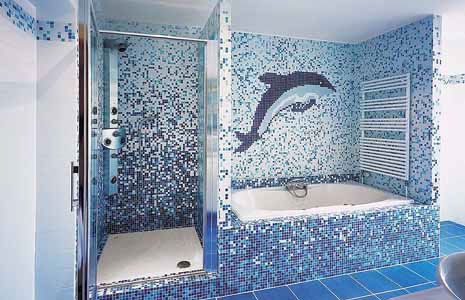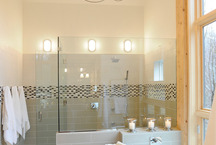
Photo: pol-master.com
The bathroom is a specific room with high humidity and temperature difference, so the materials for wall decoration should not be afraid of such conditions, it is easy to withstand direct contact with water, to be durable, while remaining stylish and beautiful. In addition, they must be hygienic, easy to clean and resistant to alkalis and acids.
Ceramic tile remains a classic for the bathroom. A variety of colors, shapes and textures, ease of care, protection of walls from moisture, environmental friendliness and hygiene are advantages. However, its installation is difficult, time-consuming, takes a long time, and the tile can be split with careless handling.
Porcelain tile is similar to ceramic tiles, but has a higher strength and wear resistance, imitates natural stone. You can revet the bathroom mirror tiles, but here it is inferior to ceramic in strength. Not so long ago there was also a glass tile made of tempered glass, which is hygienic and durable, beautiful and durable, but quite expensive.
The mosaic looks great in the bathroom, but this work is even harder and more expensive than laying ordinary tiles. The mosaic can be ceramic, glass, of smalt (similar to glass, but more durable and expressive), stone and even metal, while the parts may be different in shape.
Plastic panels belong to the most inexpensive way to finish, and therefore look cheap, as they resemble public places. But you can choose the options for stone or wood, giving stylishness. The material is hygienic, durable, tolerates temperature changes, while it is easy to install and maintain. Mechanically not too durable, afraid of impact or strong pressure.
Drywall can be used if it is water resistant or cement-based. Quite inexpensive, with a small weight, it is conveniently mounted, increases sound insulation and energy saving. However, this material requires additional decoration.
Paint also applies to traditional materials, requires an ideal surface. Only moisture resistant, dirt resistant varieties, better latex paint. Inexpensive option, giving a wealth of choice of colors and shades, as well as allowing you to create patterns for stencil or artistic painting. Requires careful maintenance.
Sometimes the bathroom walls are veneered with washable waterproof wallpaper, preferably also resistant to abrasion (fiberglass, vinyl or acrylic). On top of the wallpaper, you can also paint, increasing durability. But the strength of the wallpaper in the bathroom still leaves much to be desired, the durability is not discussed here.
Wood looks gorgeous everywhere, but for the bathroom it needs to be treated with antiseptics and water repellents. Not the cheapest option, besides requires careful special care. You can also choose wooden laminated panels.
Pasting a special self-adhesive film gives a choice of a large number of colors and textures, is cheap. You can pick up original solutions, but you will not be able to achieve a luxurious look. Not very strong and durable material, it can blister and even peel off.
The finishing of the bathroom can be done with decorative plaster, which is inexpensive and fairly reliable, only here it is necessary to choose and apply the plaster mixture with the necessary additives and plasticizers. The work is not easy and “dirty”, it takes a lot of time.
Agglomerate refers to fairly new materials, resembles ceramics, is a thin tile with a glossy surface of various colors, more durable against abrasion and mechanical impact, simpler than tile in laying. However, this artificial material, while quite expensive, can be deformed if not properly stored.
Marble is an excellent natural material for a bath, luxurious but expensive. It is durable, environmentally friendly, resistant to water, while "breathing". However, it places special demands on care and is afraid of acidic substances.
There is a kind of linoleum for walls. It has no fabric base, is completely synthetic and is similar to a sheet of plastic. Make it while to order. However, durability, plasticity and ease of care give their advantages in the direction of choosing such an unusual material.
At the same time, different materials can be combined with each other, locating in “wet” zones, where contact with water is most likely, say, ceramic tile, and finishing other areas with more demanding materials.

